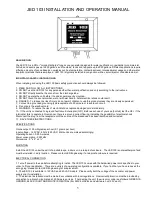
HF197AEN_v0501_04
Page 37
6. MAINTENANCE
6.1. GENERAL
DIRECTIONS
Mounting, electrical installation, start-up and maintenance of the instrument may only
be carried out by trained personnel authorized by the operator of the facility. Personnel
must read and understand this Operating Manual before carrying out its instructions.
The F197-A may only be operated by personnel who are authorized and trained by the
operator of the facility. All instructions in this manual are to be observed.
Ensure that the measuring system is correctly wired up according to the wiring
diagrams. Protection against accidental contact is no longer assured when the housing
cover is removed or the panel cabinet has been opened (danger from electrical shock).
The housing may only be opened by trained personnel.
Take careful notice of the " Safety rules, instructions and precautionary measures " in
the front of this manual.
The F197-A does not require special maintenance unless it is used in low-temperature applications
or surroundings with high humidity (above 90% annual mean). It is the users responsibility to take all
precautions to dehumidify the internal atmosphere of the F197-A in such a way that no condensation
will occur, for example by placing dry silica-gel sachet in the casing just before closing it.
Furthermore, it is required to replace or dry the silica gel periodically as advised by the silica gel
supplier.
Battery life-time:
It is influenced by several issues :
Display update: fast display update uses significantly more power; SETUP 41.
Alarm outputs and communication.
Low temperatures; the available power will be less due to battery chemistry.
Note:
It is strongly advised to disable unused functions.
Check periodically:
The condition of the casing, cable glands and front panel.
The input/output wiring for reliability and aging symptoms.
The process accuracy. As a result of wear and tear, re-calibration of the sensor might be
necessary. Do not forget to re-enter any subsequent Span alterations.
The indication for low-battery.
Clean the casing with soapy-water. Do not use any aggressive solvents as these might damage
the polyester coating.








































